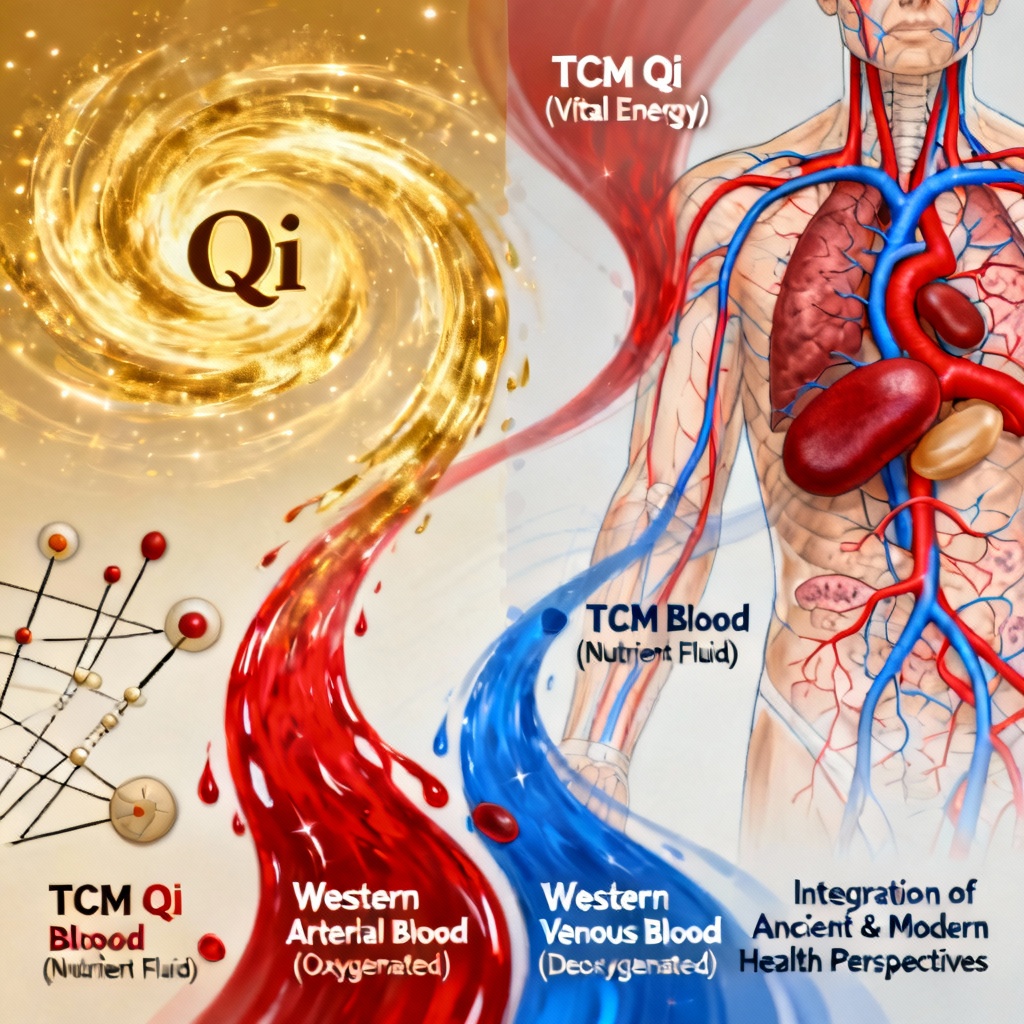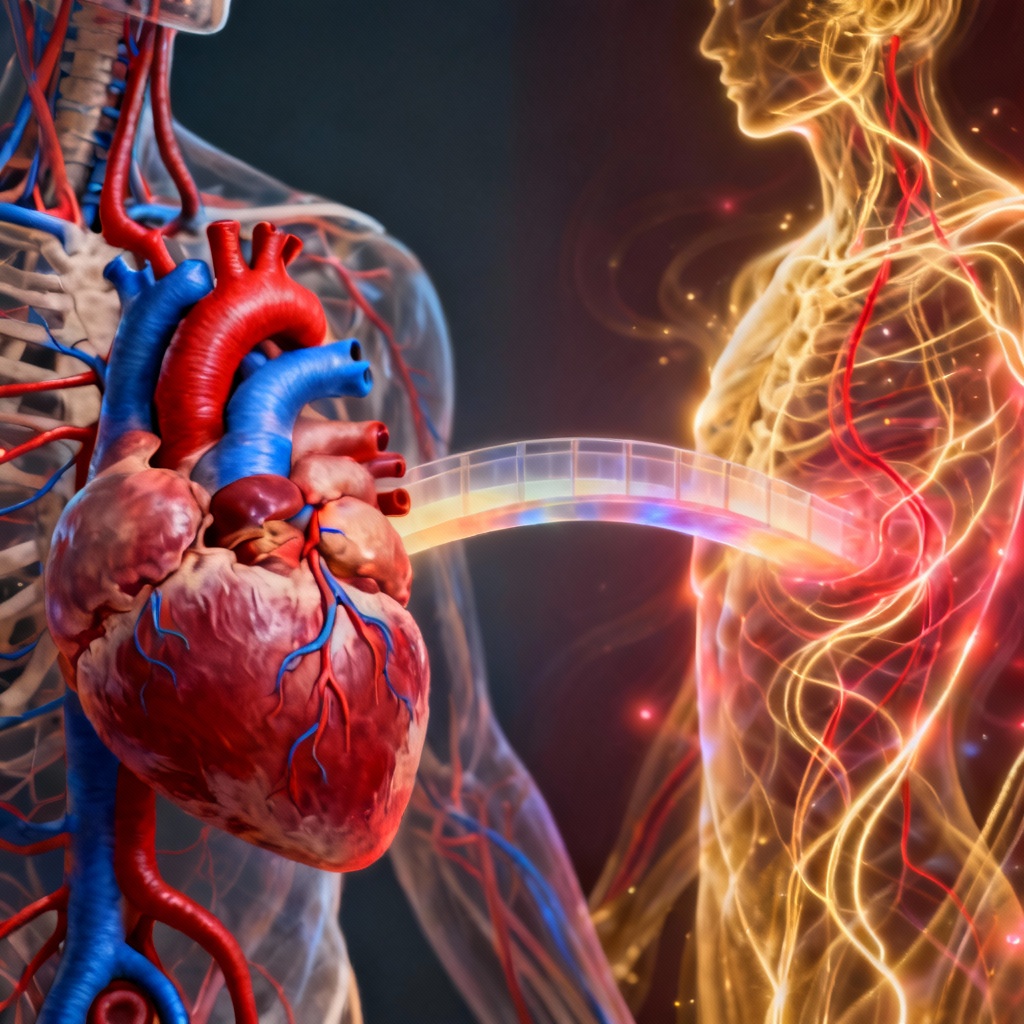In Traditional Chinese Medicine (TCM), the concept of Qi and Blood vs. Blood Circulation offers a truly fascinating health perspective. Both ideas discuss vital flowing substances in the body. They share some surprising similarities, actually. However, their theoretical depth and overall scope diverge significantly. This article will unravel these intriguing differences for you. Get ready to discover a deeper understanding of your body’s vital systems. You might be surprised by what you learn.

Surprisingly Similar, Yet Radically Different: Qi and Blood vs. Blood Circulation
Understand the Parallels: How Both Systems Value Flow
Both Western medicine and TCM acknowledge vital flowing substances are crucial for health. Western blood circulation focuses on blood moving through vessels. It delivers oxygen and nutrients to all organs. TCM’s understanding of Blood also involves nourishing and hydrating the entire body. Furthermore, both systems emphasize smooth, unimpeded flow. Western medicine worries about clots blocking arteries. TCM stresses the importance of clear, unobstructed pathways for fluid movement. This ensures overall vitality.
Expand Your Understanding: Uncover Deeper Meanings
The scope of these two systems differs quite dramatically. Western blood circulation primarily refers to the cardiovascular system. Conversely, TCM’s Qi and Blood encompasses a much broader range. TCM’s ‘Blood’ includes more than just your red blood cells. It encompasses all body fluids, like lymph and tissue fluid. These fluids provide vital nourishment throughout your body. Meanwhile, ‘Qi’ (pronounced “chee”) is even more expansive. Imagine Qi as the very life force powering everything. It is like the invisible Wi-Fi signal connecting all your bodily functions. This vital energy governs nerve transmission. It also regulates endocrine balance and immune responses. This holistic energy system manages all your body’s interconnected processes, impacting everything from mental clarity to physical strength and overall well-being. Read more about this fascinating concept in our TCM Basics: Qi and Blood section.
Shift Your Perspective: From Structure to Function
Their foundational theoretical frameworks are also distinct. Western medicine begins with anatomical structures. It specifically studies the heart, vessels, and blood components. Researchers meticulously examine their precise individual functions. However, TCM starts from functional states. It focuses on the coordinated circulation of Qi and Blood throughout the entire body. This system deeply emphasizes achieving and maintaining overall internal balance. This ensures optimal health.
Feel the Difference: Unique Diagnostic Insights
Diagnostic methods used by each system further highlight their differences. Western medicine uses objective tests. These include blood pressure readings, EKGs, and angiography. These tools precisely assess specific circulatory functions. TCM, however, relies on unique diagnostic techniques. These involve observation, listening, smelling, and asking questions. Pulse diagnosis, or ‘Mài Zhěn’, is especially crucial. Practitioners feel the rhythm and strength of your Qi and Blood movement. This offers a deeply personalized assessment. (PMID: 33749718)
Heal Holistically: Diverse Treatment Pathways
Therapeutic approaches for circulation issues also vary greatly. Western medicine directly intervenes with medications. These might include vasodilators, anticoagulants, or heart strengtheners. TCM, on the other hand, focuses on holistic regulation of Qi and Blood. Acupuncture helps to clear blocked energy pathways, like unjamming a congested freeway. Herbal medicine aims to replenish and invigorate Qi and Blood levels. Dietary therapy works to balance Yin and Yang. These methods restore overall harmony. Explore more about these therapies in our Herbal Medicine section.
Target Specific Issues: High Blood Pressure Approaches
Let’s compare practical applications, starting with high blood pressure. Western medicine prescribes medications. These drugs directly impact blood vessels and the heart. TCM, however, views high blood pressure differently. It often stems from ‘Liver Yang Rising’. This feels like an internal pressure cooker, bubbling up in your head. Or it could be ‘Phlegm-Damp obstructing pathways’. This is like sticky gunk clogging up your body’s pipes. TCM aims to soothe the Liver Yang or dissolve the Phlegm-Damp. This helps restore balance and healthy flow. Many find this holistic approach quite beneficial.

Boost Your Vitality: Anemia Treatment Options
Consider how each system addresses anemia. Western medicine supplements specific nutrients. This often includes iron or Vitamin B12. TCM diagnoses the root cause. Is it ‘Qi deficiency,’ meaning low vital energy? Or ‘Blood deficiency,’ a lack of nourishing fluids? Perhaps it’s ‘Spleen and Stomach weakness’. This means your digestive system struggles to produce enough. Different herbal formulas then nourish specific organ functions. This personalized approach truly aims for lasting results. Discover foods that can help in our Nourishing Blood Diet Therapy guide.
Steady Your Beat: Solutions for Irregular Rhythms
Finally, let’s look at irregular heartbeats. Western medicine typically uses anti-arrhythmic medications. TCM attributes arrhythmias to ‘Heart Qi deficiency’. This feels like your heart’s battery is constantly running low. Or ‘Heart Blood Stasis’, which is like stagnant, sticky blood flow. TCM focuses on calming the heart and spirit. It also invigorates blood circulation. This comprehensive method helps to restore rhythm. It also brings inner peace.
Combine Strengths: Achieve Optimal Wellness
Both systems possess powerful complementary advantages. Modern medical research increasingly shows the value of TCM. Its holistic Qi and Blood theories effectively complement Western treatments. For instance, just lowering blood pressure with drugs might miss deeper issues. It can overlook a patient’s overall body constitution. However, TCM’s Qi and Blood regulation improves the patient’s entire state. This often leads to more stable and lasting blood pressure control. This synergistic approach truly offers the best of both worlds. (PMID: 32669389)
Embrace Integrated Insights: The Core Understanding
For American readers, here’s a helpful way to grasp it. Western blood circulation studies traffic flow on a highway. It focuses on the road conditions and vehicle volume. TCM’s Qi and Blood theory, however, examines the entire transportation system. This includes urban planning, traffic signals, and vehicle performance. It considers all factors impacting efficiency. Combining both approaches solves specific problems. It also optimizes the body’s overall operation. Embrace this integrated view for comprehensive health. The understanding of Qi and Blood vs. Blood Circulation truly transforms your health journey.
References
- Traditional Chinese Medicine Pulse Diagnosis: A Narrative Review of Modern Research. (PMID: 33749718)
- Effect of Traditional Chinese Medicine on Essential Hypertension: A Systematic Review and Meta-Analysis of Randomized Controlled Trials. (PMID: 32669389)
- The ‘Qi-Blood’ theory of Traditional Chinese Medicine and its applications in clinical practice. (PMID: 29809990)
3-Second Self-Test & 30-Second Self-Rescue
Quickly assess your body’s flow and get instant relief:
- If you often feel tired, have cold hands/feet, and experience low energy → immediately try 10 deep belly breaths, focusing on expanding your abdomen to boost your Qi.
- If you experience dizziness, a pale complexion, or brittle nails → immediately drink a warm mug of ginger-date tea (steep a few slices of fresh ginger and dried dates in hot water) to nourish your Blood.
- If you’re irritable, tense, and get frequent headaches → immediately gently massage the area between your thumb and index finger (Hegu acupoint) on both hands for 15 seconds each to relieve Qi stagnation.
Medical Disclaimer:This article is for educational use only and is not a substitute for professional medical advice.